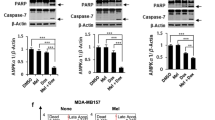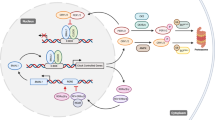Abstract
Several epidemiological studies have shown that high levels of melatonin, an indolic hormone secreted mainly by the pineal gland, reduce the risks of developing cancer, thus suggesting that melatonin triggers the activation of tumor-suppressor pathways that lead to the prevention of malignant transformation. This paper illustrates that melatonin induces phosphorylation of p53 at Ser-15 inhibiting cell proliferation and preventing DNA damage accumulation of both normal and transformed cells. This activity requires p53 and promyelocytic leukemia (PML) expression and efficient phosphorylation of p53 at Ser-15 residue. Melatonin-induced p53 phosphorylation at Ser-15 residue does not require ataxia telangiectasia-mutated activity, whereas it is severely impaired upon chemical inhibition of p38 mitogen-activated protein kinase activity. By and large, these findings imply that the activation of the p53 tumor-suppressor pathway is a critical mediator of melatonin and its anticancer effects. Therefore, it provides molecular insights into increasing observational evidence for the role that melatonin has in cancer prevention.
This is a preview of subscription content, access via your institution
Access options
Subscribe to this journal
Receive 50 print issues and online access
$259.00 per year
only $5.18 per issue
Buy this article
- Purchase on Springer Link
- Instant access to full article PDF
Prices may be subject to local taxes which are calculated during checkout







Similar content being viewed by others
References
Alpert M, Carome E, Kubulins V, Hansler R . (2009). Nighttime use of special spectacles or light bulbs that block blue light may reduce the risk of cancer. Med Hypotheses 73: 324–325.
Banin S, Moyal L, Shieh S, Taya Y, Anderson CW, Chessa L et al. (1998). Enhanced phosphorylation of p53 by ATM in response to DNA damage. Science 281: 1674–1677.
Bernardi R, Scaglioni PP, Bergmann S, Horn HF, Vousden KH, Pandolfi PP . (2004). PML regulates p53 stability by sequestering Mdm2 to the nucleolus. Nat Cell Biol 6: 665–672.
Carbone R, Pearson M, Minucci S, Pelicci PG . (2002). PML NBs associate with the hMre11 complex and p53 at sites of irradiation induced DNA damage. Oncogene 21: 1633–1640.
Chiu SJ, Chao JI, Lee YJ, Hsu TS . (2008). Regulation of gamma-H2AX and securin contribute to apoptosis by oxaliplatin via a p38 mitogen-activated protein kinase-dependent pathway in human colorectal cancer cells. Toxicol Lett 179: 63–70.
Faragher RG, Kill IR, Hunter JA, Pope FM, Tannock C, Shall S . (1993). The gene responsible for Werner syndrome may be a cell division ‘counting’ gene. Proc Natl Acad Sci USA 90: 12030–12034.
Fernandez-Capetillo O, Chen HT, Celeste A, Ward I, Romanienko PJ, Morales JC et al. (2002). DNA damage-induced G2-M checkpoint activation by histone H2AX and 53BP1. Nat Cell Biol 4: 993–997.
Flynn-Evans EE, Stevens RG, Tabandeh H, Schernhammer ES, Lockley SW . (2009). Total visual blindness is protective against breast cancer. Cancer Causes Control 20: 1753–1756.
Guo A, Salomoni P, Luo J, Shih A, Zhong S, Gu W et al. (2000). The function of PML in p53-dependent apoptosis. Nat Cell Biol 2: 730–736.
Halvorsen TL, Leibowitz G, Levine F . (1999). Telomerase activity is sufficient to allow transformed cells to escape from crisis. Mol Cell Biol 19: 1864–1870.
Haupt Y, Maya R, Kazaz A, Oren M . (1997). Mdm2 promotes the rapid degradation of p53. Nature 387: 296–299.
Helton ES, Chen X . (2007). p53 modulation of the DNA damage response. J Cell Biochem 100: 883–896.
Ji C, Ren F, Ma H, Xu M . (2010). The roles of p38MAPK and caspase-3 in DADS-induced apoptosis in human HepG2 cells. J Exp Clin Cancer Res 29: 50.
Kane MA, Johnson A, Nash AE, Boose D, Mathai G, Balmer C et al. (1994). Serum melatonin levels in melanoma patients after repeated oral administration. Melanoma Res 4: 59–65.
Kim CH, Yoo YM . (2010). Melatonin induces apoptotic cell death via p53 in LNCaP cells. Korean J Physiol Pharmacol 14: 365–369.
Kinner A, Wu W, Staudt C, Iliakis G . (2008). Gamma-H2AX in recognition and signaling of DNA double-strand breaks in the context of chromatin. Nucleic Acids Res 36: 5678–5694.
Kliukiene J, Tynes T, Andersen A . (2001). Risk of breast cancer among Norwegian women with visual impairment. Br J Cancer 84: 397–399.
Kloog I, Haim A, Stevens RG, Barchana M, Portnov BA . (2008). Light at night co-distributes with incident breast but not lung cancer in the female population of Israel. Chronobiol Int 25: 65–81.
Kloog I, Haim A, Stevens RG, Portnov BA . (2009). Global co-distribution of light at night (LAN) and cancers of prostate, colon, and lung in men. Chronobiol Int 26: 108–125.
Kubbutat MH, Jones SN, Vousden KH . (1997). Regulation of p53 stability by Mdm2. Nature 387: 299–303.
Lakin ND, Jackson SP . (1999). Regulation of p53 in response to DNA damage. Oncogene 18: 7644–7655.
Lapi E, Di Agostino S, Donzelli S, Gal H, Domany E, Rechavi G et al. (2008). PML, YAP, and p73 are components of a proapoptotic autoregulatory feedback loop. Mol Cell 32: 803–814.
Lipton J, Megerian JT, Kothare SV, Cho YJ, Shanahan T, Chart H et al. (2009). Melatonin deficiency and disrupted circadian rhythms in pediatric survivors of craniopharyngioma. Neurology 73: 323–325.
Lukas J, Bartek J . (2009). DNA repair: new tales of an old tail. Nature 458: 581–583.
Markantonis SL, Tsakalozou E, Paraskeva A, Staikou C, Fassoulaki A . (2008). Melatonin pharmacokinetics in premenopausal and postmenopausal healthy female volunteers. J Clin Pharmacol 48: 240–245.
Mediavilla MD, Cos S, Sanchez-Barcelo EJ . (1999). Melatonin increases p53 and p21WAF1 expression in MCF-7 human breast cancer cells in vitro. Life Sci 65: 415–420.
Nur EKA, Li TK, Zhang A, Qi H, Hars ES, Liu LF . (2003). Single-stranded DNA induces ataxia telangiectasia mutant (ATM)/p53-dependent DNA damage and apoptotic signals. J Biol Chem 278: 12475–12481.
Oren M . (2003). Decision making by p53: life, death and cancer. Cell Death Differ 10: 431–442.
Pearson M, Pelicci PG . (2001). PML interaction with p53 and its role in apoptosis and replicative senescence. Oncogene 20: 7250–7256.
Roy D, Angelini NL, Fujieda H, Brown GM, Belsham DD . (2001). Cyclical regulation of GnRH gene expression in GT1-7 GnRH-secreting neurons by melatonin. Endocrinology 142: 4711–4720.
Sainz RM, Mayo JC, Tan DX, Leon J, Manchester L, Reiter RJ . (2005). Melatonin reduces prostate cancer cell growth leading to neuroendocrine differentiation via a receptor and PKA independent mechanism. Prostate 63: 29–43.
Schernhammer ES, Berrino F, Krogh V, Secreto G, Micheli A, Venturelli E et al. (2010). Urinary 6-sulphatoxymelatonin levels and risk of breast cancer in premenopausal women: the ORDET cohort. Cancer Epidemiol Biomarkers Prev 19: 729–737.
Schernhammer ES, Berrino F, Krogh V, Secreto G, Micheli A, Venturelli E et al. (2008). Urinary 6-sulfatoxymelatonin levels and risk of breast cancer in postmenopausal women. J Natl Cancer Inst 100: 898–905.
She QB, Chen N, Dong Z . (2000). ERKs and p38 kinase phosphorylate p53 protein at serine 15 in response to UV radiation. J Biol Chem 275: 20444–20449.
Shieh SY, Ikeda M, Taya Y, Prives C . (1997). DNA damage-induced phosphorylation of p53 alleviates inhibition by MDM2. Cell 91: 325–334.
Shiloh Y . (2003). ATM and related protein kinases: safeguarding genome integrity. Nat Rev Cancer 3: 155–168.
Shrivastav M, De Haro LP, Nickoloff JA . (2008). Regulation of DNA double-strand break repair pathway choice. Cell Res 18: 134–147.
Sliwinski T, Rozej W, Morawiec-Bajda A, Morawiec Z, Reiter R, Blasiak J . (2007). Protective action of melatonin against oxidative DNA damage: chemical inactivation versus base-excision repair. Mutat Res 634: 220–227.
Unger T, Sionov RV, Moallem E, Yee CL, Howley PM, Oren M et al. (1999). Mutations in serines 15 and 20 of human p53 impair its apoptotic activity. Oncogene 18: 3205–3212.
Vakkuri O, Leppaluoto J, Kauppila A . (1985). Oral administration and distribution of melatonin in human serum, saliva and urine. Life Sci 37: 489–495.
Wang Y, Prives C . (1995). Increased and altered DNA binding of human p53 by S and G2/M but not G1 cyclin-dependent kinases. Nature 376: 88–91.
Xi SC, Tam PC, Brown GM, Pang SF, Shiu SY . (2000). Potential involvement of mt1 receptor and attenuated sex steroid-induced calcium influx in the direct anti-proliferative action of melatonin on androgen-responsive LNCaP human prostate cancer cells. J Pineal Res 29: 172–183.
Xian ZH, Cong WM, Zhang SH, Wu MC . (2005). Genetic alterations of hepatocellular carcinoma by random amplified polymorphic DNA analysis and cloning sequencing of tumor differential DNA fragment. World J Gastroenterol 11: 4102–4107.
Acknowledgements
We thank Dr E O’Neill and Dr Y Shiloh for gift of reagents and cell lines. Moreover, we also thank T Merlino for kindly revising the English text. This study was supported by Associazione Italiana Ricerca sul Cancro (AIRC, to SS and GB), Ministero della Salute (GB and PM), Fondazione Veronesi (GB), FIRB (GB), New Idea Award (SS) and Fondazione Italiana Ricerca sul Cancro (FIRC, fellowship to RS).
Author information
Authors and Affiliations
Corresponding author
Ethics declarations
Competing interests
The authors declare no conflict of interest.
Additional information
Supplementary Information accompanies the paper on the Oncogene website )
Rights and permissions
About this article
Cite this article
Santoro, R., Marani, M., Blandino, G. et al. Melatonin triggers p53Ser phosphorylation and prevents DNA damage accumulation. Oncogene 31, 2931–2942 (2012). https://doi.org/10.1038/onc.2011.469
Received:
Revised:
Accepted:
Published:
Issue Date:
DOI: https://doi.org/10.1038/onc.2011.469
Keywords
This article is cited by
-
The rationale for treating uveal melanoma with adjuvant melatonin: a review of the literature
BMC Cancer (2022)
-
Melatonin Reverses 10-Hydroxycamptothecin-Induced Apoptosis and Autophagy in Mouse Oocyte
Reproductive Sciences (2021)
-
Melatonin: an endogenous miraculous indolamine, fights against cancer progression
Journal of Cancer Research and Clinical Oncology (2020)
-
Effects of melatonin administration on embryo implantation and offspring growth in mice under different schedules of photoperiodic exposure
Reproductive Biology and Endocrinology (2017)
-
Melatonin and its metabolites protect human melanocytes against UVB-induced damage: Involvement of NRF2-mediated pathways
Scientific Reports (2017)



